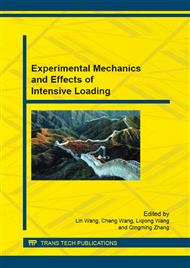[1]
A. Assadi-Lamouki, T. Krauthammer, An explicit finite difference approach for the Mindlin plate analysis, Computers & Structures, 31 (1989) 487-494.
DOI: 10.1016/0045-7949(89)90325-8
Google Scholar
[2]
T. Krauthammer, A. Assadi-Lamouki, H.M. Shanaa, Analysis of impulsively loaded reinforced concrete structural elements—I. Theory, Computers & Structures, 48 (1993) 851-860.
DOI: 10.1016/0045-7949(93)90507-a
Google Scholar
[3]
T. Krauthammer, A. Assadi-Lamouki, H.M. Shanaa, Analysis of impulsively loaded reinforced concrete structural elements—II. Implementation, Computers & Structures, 48 (1993) 861-871.
DOI: 10.1016/0045-7949(93)90508-b
Google Scholar
[4]
G. Mays, J. Hetherington, T. Rose, Response to Blast Loading of Concrete Wall Panels with Openings, Journal of Structural Engineering, 125 (1999) 1448-1450.
DOI: 10.1061/(asce)0733-9445(1999)125:12(1448)
Google Scholar
[5]
P.D. Smith, G.C. Mays, T.A. Rose, K.G. Teo, B.J. Roberts, Small scale models of complex geometry for blast overpressure assessment, International Journal of Impact Engineering, 12 (1992) 345-360.
DOI: 10.1016/0734-743x(92)90112-7
Google Scholar
[6]
A. Schenker, I. Anteby, E. Gal, Y. Kivity, E. Nizri, O. Sadot, R. Michaelis, O. Levintant, G. Ben-Dor, Full-scale field tests of concrete slabs subjected to blast loads, International Journal of Impact Engineering, 35 (2008) 184-198.
DOI: 10.1016/j.ijimpeng.2006.12.008
Google Scholar
[7]
J. Chen, X. Huang, R. Ma, M. He, Experimental Study on the Progressive Collapse Resistance of a Two-Story Steel Moment Frame, Journal of Performance of Constructed Facilities, 26 (2012) 567-575.
DOI: 10.1061/(asce)cf.1943-5509.0000287
Google Scholar
[8]
M. Sasani, A. Kazemi, S. Sagiroglu, S. Forest, Progressive Collapse Resistance of an Actual 11-Story Structure Subjected to Severe Initial Damage, Journal of Structural Engineering, 137 (2011) 893-902.
DOI: 10.1061/(asce)st.1943-541x.0000418
Google Scholar
[9]
W. -J. Yi, Q. -F. He, Y. Xiao, S.K. Kunnath, Experimental study on progressive collapse-resistant behavior of reinforced concrete frame structures, ACI Structural Journal, 105 (2008) 433.
DOI: 10.14359/19857
Google Scholar
[10]
B. Luccioni, R. Ambrosini, R. Danesi, Analysis of building collapse under blast loads, Engineering Structures, 26 (2004) 63-71.
DOI: 10.1016/j.engstruct.2003.08.011
Google Scholar
[11]
J. Li, H. Hao, Numerical study of concrete spall damage to blast loads, International Journal of Impact Engineering, 68 (2014) 41-55.
DOI: 10.1016/j.ijimpeng.2014.02.001
Google Scholar
[12]
H. Hao, C. -Q. Wu, Z. -X. Li, A. ABDULLAH, Numerical analysis of structural progressive collapse to blast loads, tansactions of Tianjin University, 12 (2006).
Google Scholar
[13]
Y. Shi, Z. -X. Li, H. Hao, A new method for progressive collapse analysis of RC frames under blast loading, Engineering Structures, 32 (2010) 1691-1703.
DOI: 10.1016/j.engstruct.2010.02.017
Google Scholar
[14]
J.M. Biggs, J.M. Biggs, Introduction to structural dynamics, McGraw-Hill College, (1964).
Google Scholar
[15]
T. Krauthammer, N. Bazeos, T. Holmquist, Modified SDOF Analysis of RC Box‐Type Structures, Journal of Structural Engineering, 112 (1986) 726-744.
DOI: 10.1061/(asce)0733-9445(1986)112:4(726)
Google Scholar
[16]
J. Li, H. Hao, Numerical study of structural progressive collapse using substructure technique, Engineering Structures, 52 (2013) 101-113.
DOI: 10.1016/j.engstruct.2013.02.016
Google Scholar
[17]
L.J. Malvar, J.E. Crawford, Dynamic increase factors for concrete, in, DTIC Document, (1998).
Google Scholar
[18]
L. Malvar, J. Crawford, Dynamic increase factors for steel reinforcing bars [C], in: 28th DDESB Seminar. Orlando, USA, (1998).
Google Scholar
[19]
J. Li, H. Hao, A Two-step Numerical Method for Efficient Analysis of Structural Response to Blast Load, International Journal of Protective Structures, 2 (2011) 103-126.
DOI: 10.1260/2041-4196.2.1.103
Google Scholar
[20]
J. Li, H. Hao, Influence of brittle shear damage on accuracy of the two-step method in prediction of structural response to blast loads, International Journal of Impact Engineering, 54 (2013) 217-231.
DOI: 10.1016/j.ijimpeng.2012.11.008
Google Scholar
[21]
R. Guyan, Reduction of mass and stiffness matrices, AIAA Journal, 3 (1965) 380.
Google Scholar


